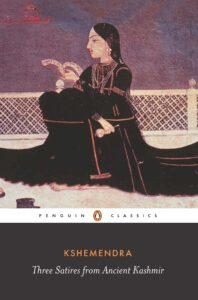 Indians have been familiar with the concept of rasa (emotions) since ancient times, with wry humor being found everywhere. Glimpses of Hāsya Rasa, or the ‘sentiment of laughter’ can even be found in the Ṛigveda, in its Frog Hymn. From funny to satirical Sanskrit verses, we find the use of humor for critiquing and mocking figures of power, religion and sanctity. In this regard, the works of Kṣemendra, a distinguished Kashmiri satirist of the eleventh century, are prominent.
Indians have been familiar with the concept of rasa (emotions) since ancient times, with wry humor being found everywhere. Glimpses of Hāsya Rasa, or the ‘sentiment of laughter’ can even be found in the Ṛigveda, in its Frog Hymn. From funny to satirical Sanskrit verses, we find the use of humor for critiquing and mocking figures of power, religion and sanctity. In this regard, the works of Kṣemendra, a distinguished Kashmiri satirist of the eleventh century, are prominent.
One of the many Kashmiri writers who contributed immensely to the development and spread of the Sanskrit language and literature, Kṣemendra, also known as Vyāsadāsa, used satire to expose the prevailing vices and follies and to present a realistic representation of Kashmiri society. Born in a well-to-do family, Kshemendra was the disciple of Abhinavagupta. He wrote during the reign of the Kashimirian kings Ananta and Kalasa and thus, his literary career has been approximated to fall between 1010 CE and 1066 CE.
It was only in 1871, CE. Burnell discovered the first manuscript attributed to Kshemendra at Tanjore. Of the nearly 30 works credited to him, around eighteen survive. He was versatile and in addition to satire, he wrote poems, narratives, didactic sketches and quite a number of treatises on diverse subjects. His bold and lucid style marked his distinctiveness. His Bṛhatkathā-mañjarī is the earliest textual version found in the Vetāla anthology (the Twenty-Five Tales of the Animated Corpse’). Aucityavicara-carca and Kavi-kanthabharana are unique in the sense that they deal with the art of poetry; the question of Aucitya or propriety in Kavya (Aucitya-vicara-carca), and the traits of a great poem and poet (Kavikanthabharana). He wrote both Hindu (Ramayana Manjari, Mahabharta Manjari) and Buddhist (Baudvandana Kalaplata) lores.
As one of the earliest social satirists, he used his craft to highlight the social evils and exploitation prevalent in contemporary society. His characters in Kalavilasa, Samayamātrikā, Narmamālā (A Garland of Seductions) and Deśopadeśa (Advice from the Countryside), were drawn from everyday life which enabled the reader to resonate with the storyline.
Samayamātrikā, a poem of eight chapters on the wanderings of a courtesan paints a vivid picture of a society pursuing sex and money. Desopadesa presents a realistic description of the society through caricatures of the lives of various deprived sections of the community. He used Narmamala, which is in the form of a narrative, to severely criticize the corrupt and exploitative Kayasthas (clerk). Kalavilasa depicts the various occupations, scams and follies prevalent during those times. There is also a reference to Muladeva, who is supposed to be a legendary master of trickery.
Kshemendra did not spare anyone in his satires; from alchemists to astrologers, political and religious leaders to cheating gamblers, he ridiculed everyone. A master of wit and humor, his analogies and descriptions are fresh and often shocking, like the guru whose mouth twitches ‘like the cunt of an old she-buffalo’, the astrologer who consults ‘knowledgeable fisherman’ about the likelihood of rain, the doctor who must kill thousands of patients with experimental concoctions before establishing his reputation, and the man who gives himself love bites and smears lipstick on his collar before going out.
Though at times, his work might appear misogynist, Kshemendra holds an eminent position in the whole range of Sanskrit literature. With the spirit of a reformer, he used his satire to lay bare all the loopholes, hypocrisies and absurdities of society in order to drive out the evils.

